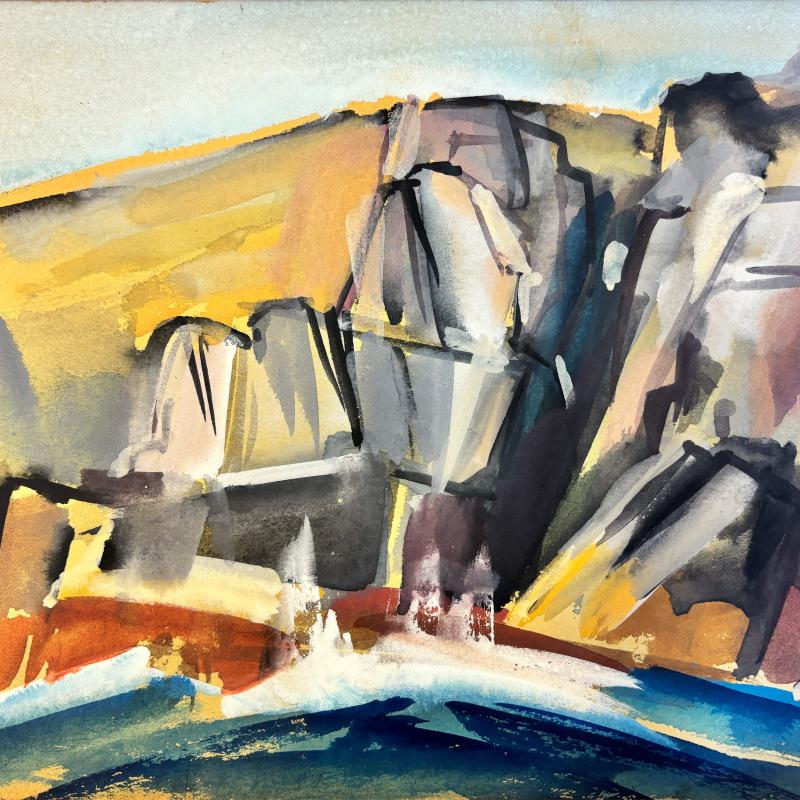-
 Albert WeinEquus, modeled circa 1979, this cast 1988Bronze on black Micarta base17 3/4 x 17 x 8 1/4 inches
Albert WeinEquus, modeled circa 1979, this cast 1988Bronze on black Micarta base17 3/4 x 17 x 8 1/4 inches
Black Micarta plinth: 2 x 14 x 7 1/2 inchesSigned: © A. Wein 4/12 top rear of self-base
Marked: Bedi Makky Fdry edge of self-base
-
 Albert WeinDancing Girl, Modeled 1947-48, this cast 1987Bronze12 3/4 x 3 1/2 x 2Signed: WEIN SC along base, Marked: © ‘87 2/12 TX (Tallix Foundry mark) along base
Albert WeinDancing Girl, Modeled 1947-48, this cast 1987Bronze12 3/4 x 3 1/2 x 2Signed: WEIN SC along base, Marked: © ‘87 2/12 TX (Tallix Foundry mark) along base
-
 Albert WeinShibui, circa 1960sBronze11 1/4 x 2 3/4 x 3 inches
Albert WeinShibui, circa 1960sBronze11 1/4 x 2 3/4 x 3 inches
Artist made wood base: 4 x 4 x 2 3/4 inchesSigned: AW [cypher] 1/13 at base
-
 Albert WeinArchangel, circa 1960-65Cast Bronze9 1/4 x 6 1/2 x 4 1/2 inches
Albert WeinArchangel, circa 1960-65Cast Bronze9 1/4 x 6 1/2 x 4 1/2 inches
Marble base: 2 x 2 1/2 x 2 3/8 inchesSigned: AW [cypher] 1/9 lower proper right
-
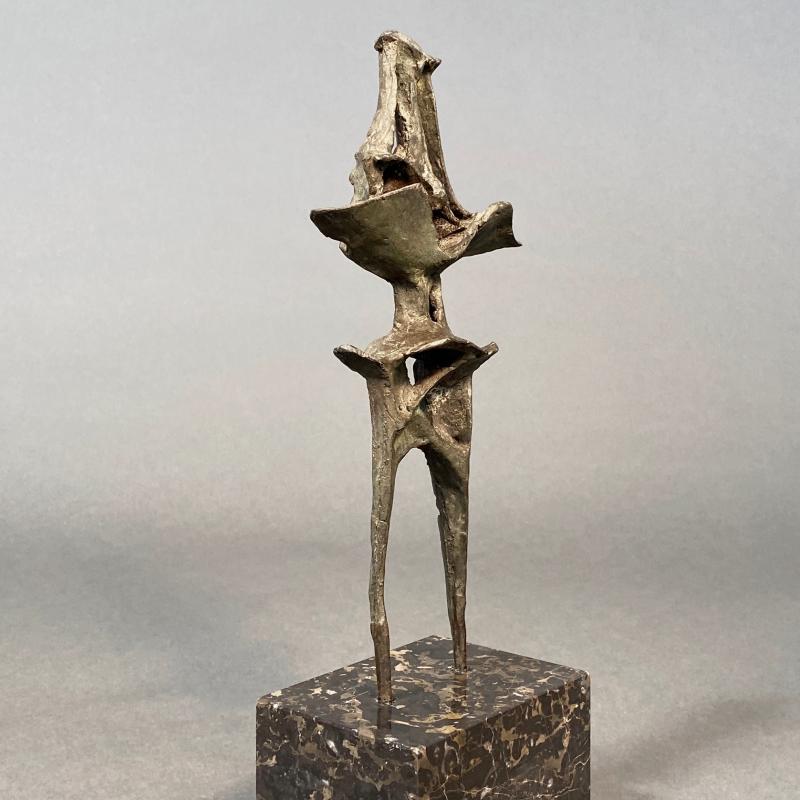 Albert WeinContrapunto, circa 1960-65Welded Bronze12 1/4 x 5 3/4 x 2 inches
Albert WeinContrapunto, circa 1960-65Welded Bronze12 1/4 x 5 3/4 x 2 inches
Marble base: 3 x 5 x 4 inches
15 1/4 inches high overallUnsigned
-
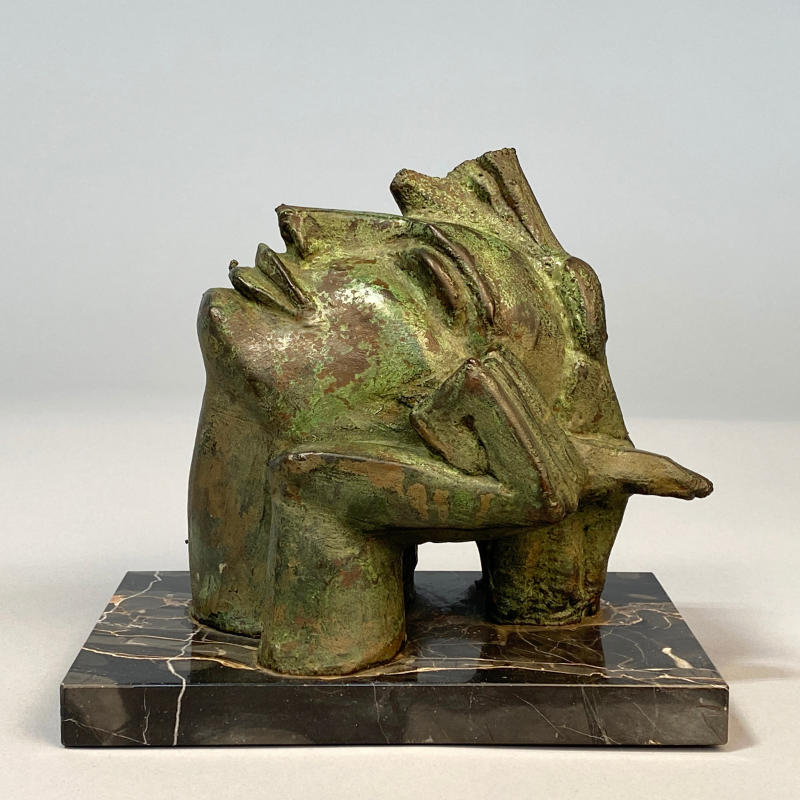 Albert WeinHead, circa 1960-65Bronze with green patina6 1/4 x 5 x 7 inches
Albert WeinHead, circa 1960-65Bronze with green patina6 1/4 x 5 x 7 inches
Marble base: 3/4 x 5 x 8 inchesUnsigned
-
 Albert WeinTête-à-Tête, circa 1960-65Bronze16 3/4 x 4 3/4 x 4 3/8 inches
Albert WeinTête-à-Tête, circa 1960-65Bronze16 3/4 x 4 3/4 x 4 3/8 inches
Marble base: 2 3/4 x 6 x 5 inchesSigned: Wein under lower element
-
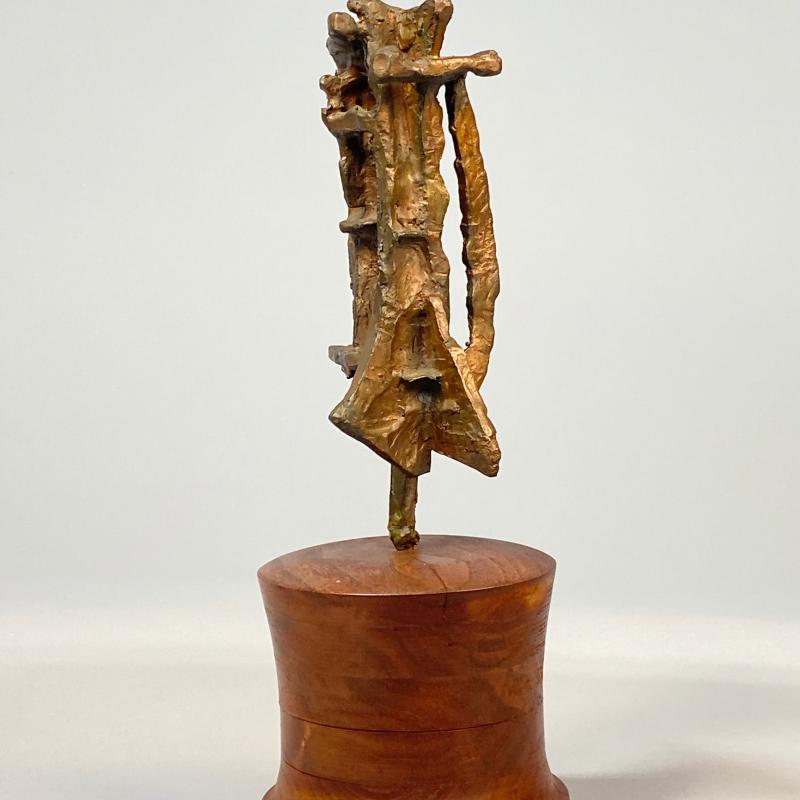 Albert WeinTotem #1, circa 1960-65Bronze8 1/4 x 4 x 3 1/4 inches,
Albert WeinTotem #1, circa 1960-65Bronze8 1/4 x 4 x 3 1/4 inches,
Artist made wood base: 4 1/2 high x 4 3/4 inches diameterSigned: AW [cypher]
-
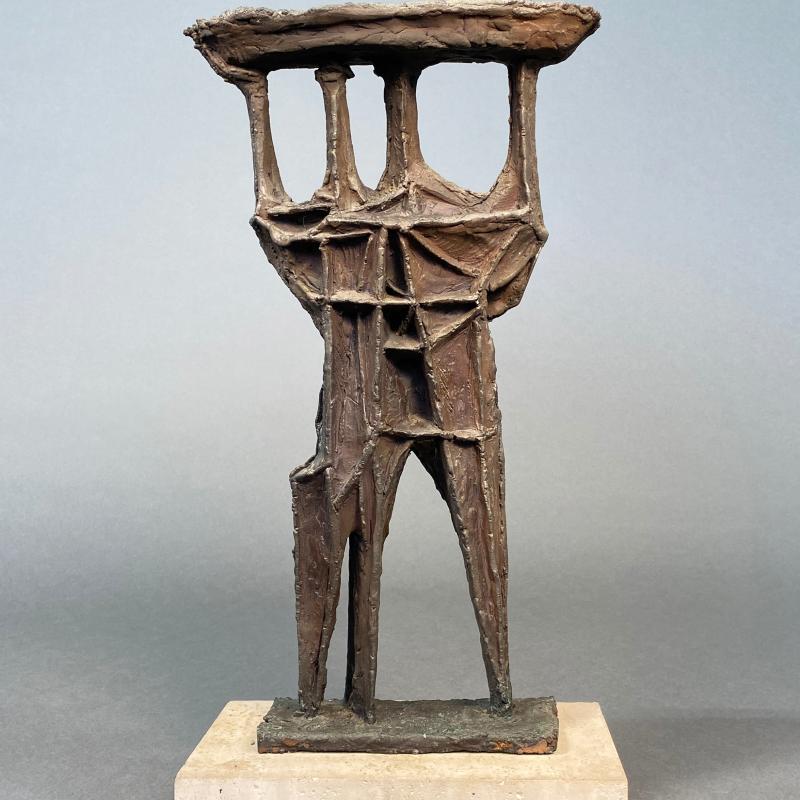 Albert WeinWater Collectors, circa 1960-65Bronze with variegated patina15 3/4 x 9 x 3 inches
Albert WeinWater Collectors, circa 1960-65Bronze with variegated patina15 3/4 x 9 x 3 inches
Stone base: 2 1/2 x 9 x 5 inches
18 inches high overallUnsigned
-
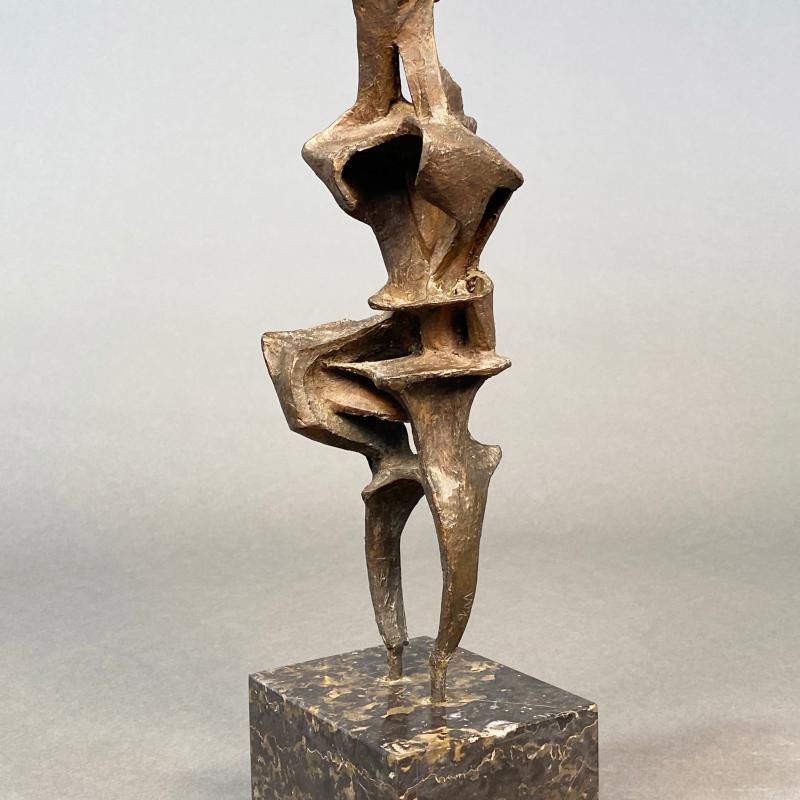 Albert WeinEmbrace, circa 1960 - 65Cast Bronze12 1/8 x 3 3/4 x 3 1/2 inches
Albert WeinEmbrace, circa 1960 - 65Cast Bronze12 1/8 x 3 3/4 x 3 1/2 inches
Marble base: 3 x 5 x 4 inchesSigned: AW [cypher] 1/6 proper left leg
-
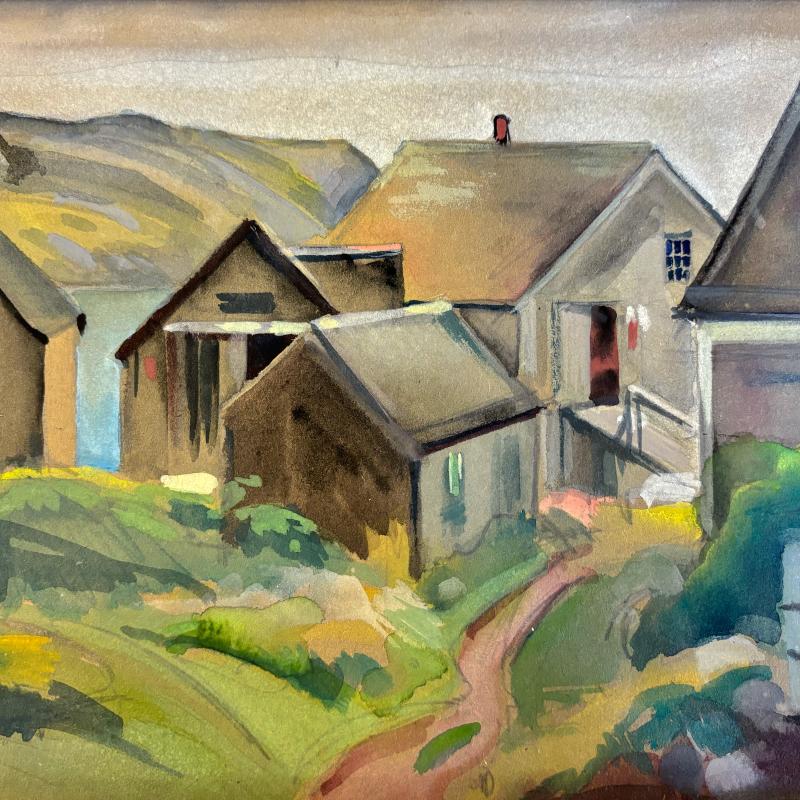 Albert WeinMonhegan Path, Circa 1949Watercolor9 x 12 inches
Albert WeinMonhegan Path, Circa 1949Watercolor9 x 12 inches
Framed: 20 3/8 x 23 1/2 inchesSigned: Wein lower left
-
 Albert WeinWinged Victory (also Archangel), c. 1960 - 65Bronze with brown patina12 1/8 x 7 5/8 x 6 inches
Albert WeinWinged Victory (also Archangel), c. 1960 - 65Bronze with brown patina12 1/8 x 7 5/8 x 6 inches
Base: 4 3/4 x 5 x 5 inches
-
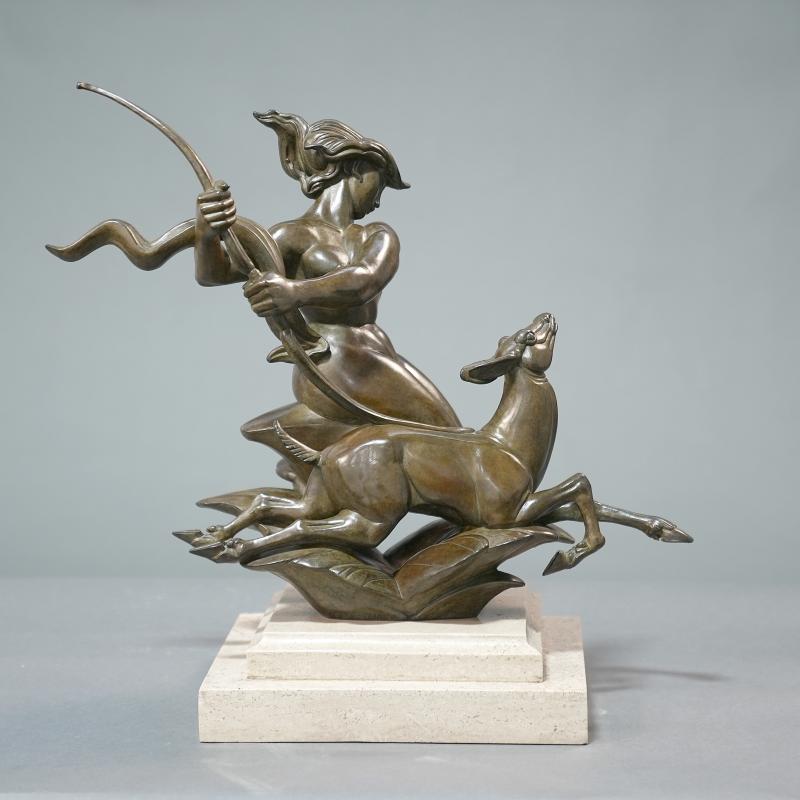 Albert WeinDiana, 1985 87Bronze18 1/2 x 22 1/2 x 8 1/4 inches
Albert WeinDiana, 1985 87Bronze18 1/2 x 22 1/2 x 8 1/4 inches
Stepped marble base: 3 1/2 x 13 x 11 inchesSigned: Wein sc 85 © 87 1/12 [Tallix foundry cypher] rear of self-base
-
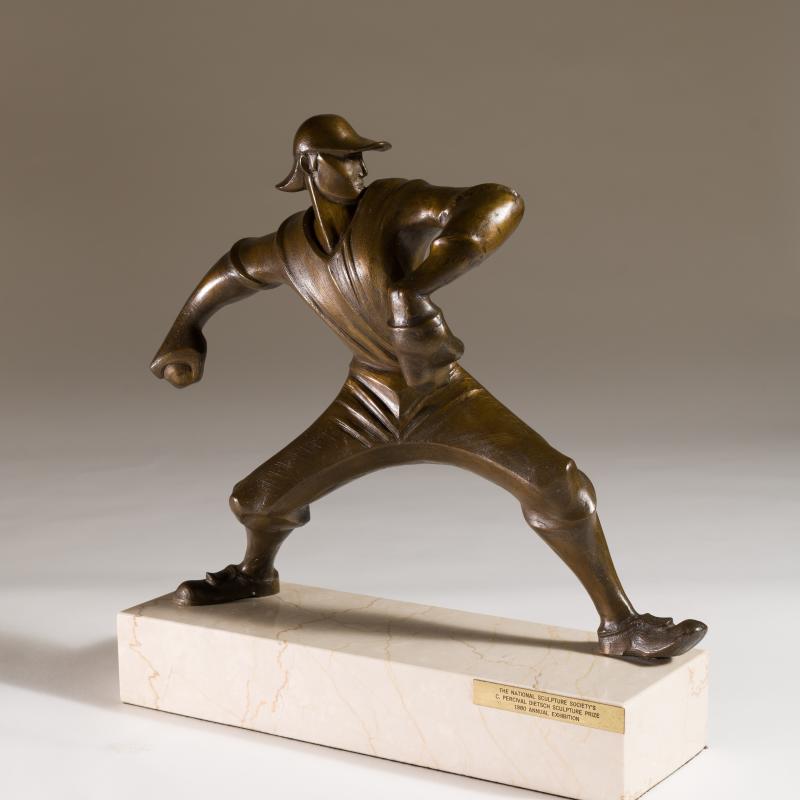 Albert WeinFastball, 1977Bronze on original marble base19 1/8 in x 18 3/4 in x 6 inches,
Albert WeinFastball, 1977Bronze on original marble base19 1/8 in x 18 3/4 in x 6 inches,
Base: 3 x 18 x 6 inchesWein 2/13 (proper right heel), Edition 2 of 13
-
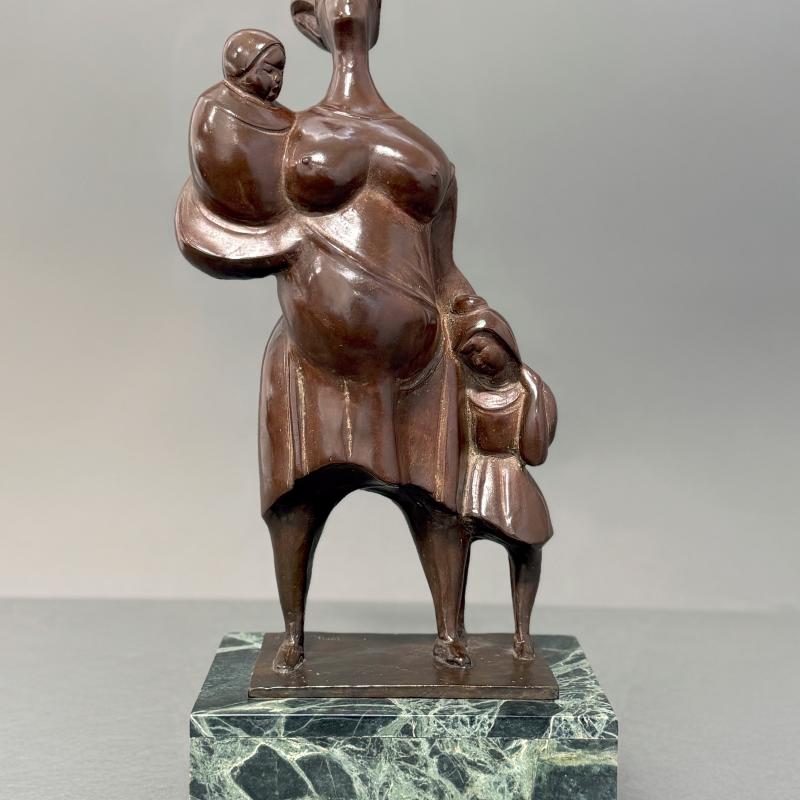 Albert WeinMother’s Jewels, 1975Bronze on artist made green marble base15 x 8 1/4 x 5 1/2 inches
Albert WeinMother’s Jewels, 1975Bronze on artist made green marble base15 x 8 1/4 x 5 1/2 inches
Base: 3 x 8 1/4 x 6 1/4 inchesSigned: Wein SC 1975 . © 87 2/12 TX [Tallix Foundry cypher] top of self-base
-
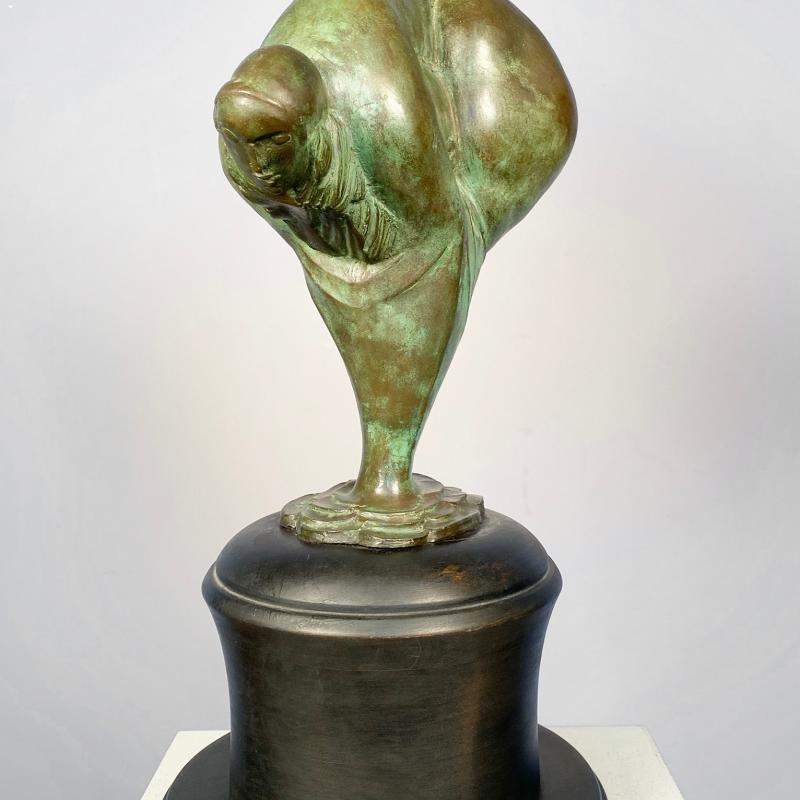 Albert WeinSeptember Morn, 1968Bronze10 3/4 x 6 x 8 1/2 inches
Albert WeinSeptember Morn, 1968Bronze10 3/4 x 6 x 8 1/2 inches
Base: 6 1/2 x 9 inches dimeterSigned: Wein 1/13 top of self-base
-
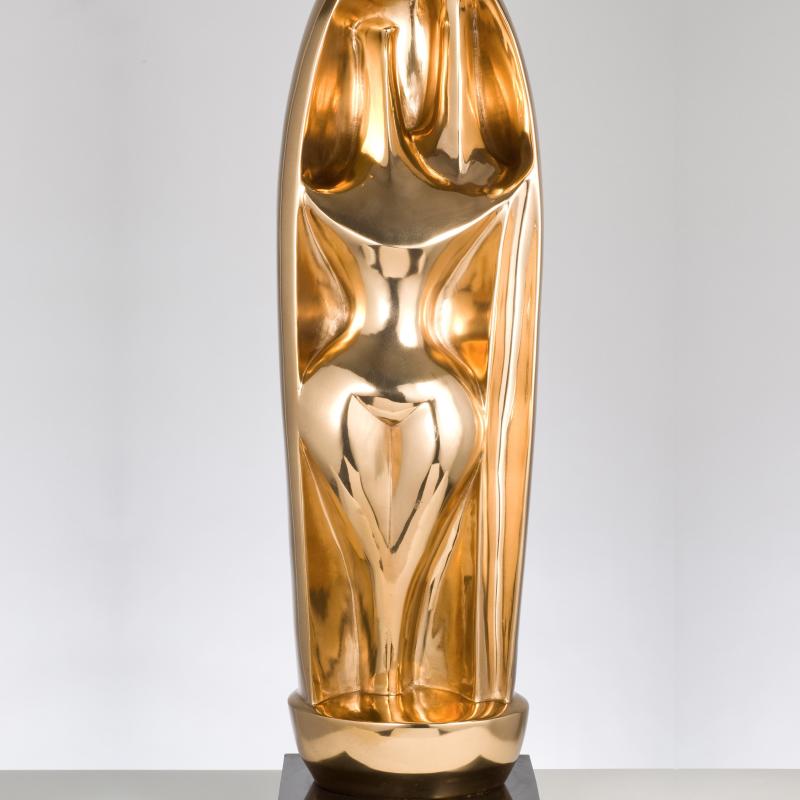 Albert WeinSymbiosis, 1968Polished bronze25 x 7 x 7 inchesSigned: Wein 1/9 at base
Albert WeinSymbiosis, 1968Polished bronze25 x 7 x 7 inchesSigned: Wein 1/9 at base
-
 Albert WeinJoie De Vivre, 1962Bronze with brown patina on rotating wood base16 x 13 3/4 x 13 3/4 inchesInscribed under skirt with Tallix foundry mark, Edition no. 4/13
Albert WeinJoie De Vivre, 1962Bronze with brown patina on rotating wood base16 x 13 3/4 x 13 3/4 inchesInscribed under skirt with Tallix foundry mark, Edition no. 4/13
-
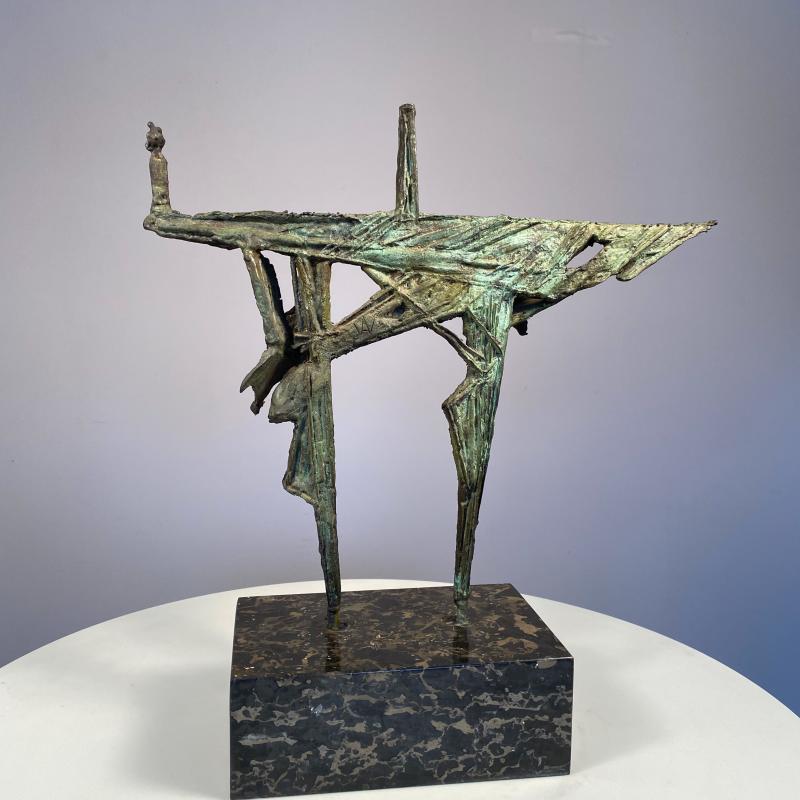 Albert WeinSeraph, 1960-65Bronze with green patina17 x 17 x 5 inchesSigned: WA [cipher] 1/6 on leg
Albert WeinSeraph, 1960-65Bronze with green patina17 x 17 x 5 inchesSigned: WA [cipher] 1/6 on leg
-
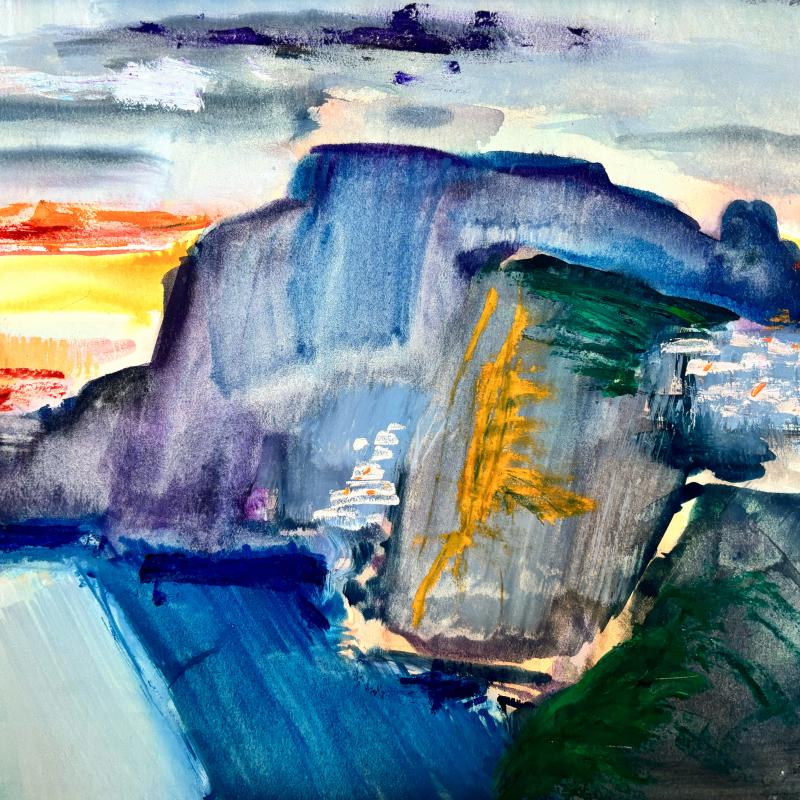 Albert WeinCapri, 1949Watercolor9 x 12 inches
Albert WeinCapri, 1949Watercolor9 x 12 inches
Framed: 17 3/4 x 20 1/2 inchesSigned: CAPRI - 49 WEIN lower right
-
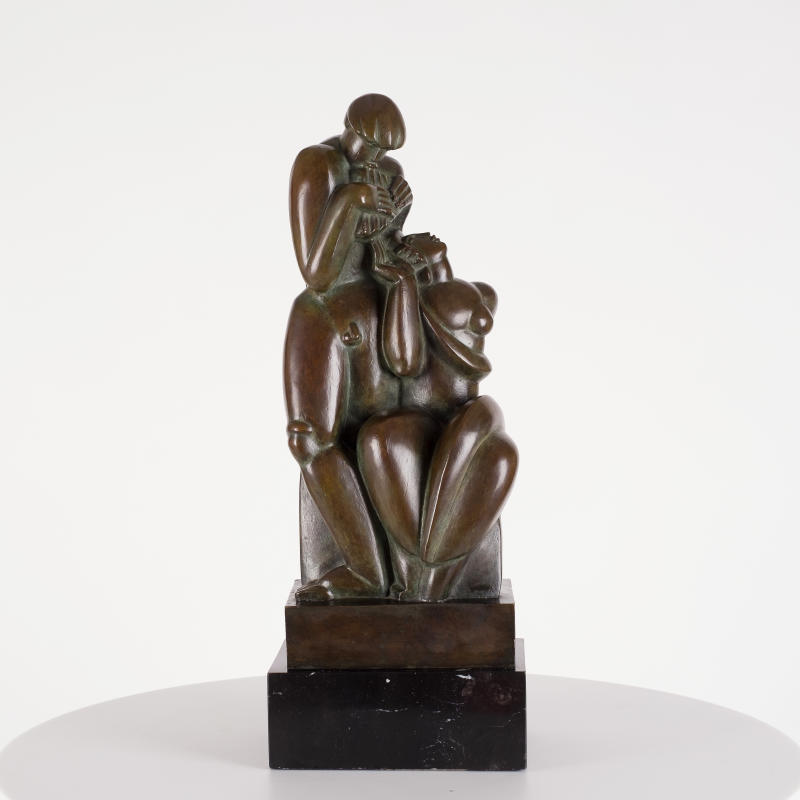 Albert WeinHomage to Bela Bartok, 1947 (this cast 1987)Bronze with verdigris on a black stone stand18 x 6 x 7 1/2 inchesSigned: WEIN SC 1947 / © ’87 / 3/12, Marked: Pollich Tallix Foundry cypher (on self-base)
Albert WeinHomage to Bela Bartok, 1947 (this cast 1987)Bronze with verdigris on a black stone stand18 x 6 x 7 1/2 inchesSigned: WEIN SC 1947 / © ’87 / 3/12, Marked: Pollich Tallix Foundry cypher (on self-base)
-
 Albert WeinDemeter, 1947Bronze on marble base22 1/8 x 6 1/2 x 10 1/2 inches,
Albert WeinDemeter, 1947Bronze on marble base22 1/8 x 6 1/2 x 10 1/2 inches,
Base: 11 inches diameter x 3 1/8 inches highSigned: WEIN SC 47 © 87 (on slef base), Marked:1/12 TX [Tallix Foundry cipher] (on self base)
-
 Albert WeinAbstractionOil on Masonite10 x 8 inches,
Albert WeinAbstractionOil on Masonite10 x 8 inches,
Framed: 17 1/2 x 15 3/4 inchesSigned: Wein (l.r.), Provenance: Estate of the Artist Private Collection, Greenwich, CT
-
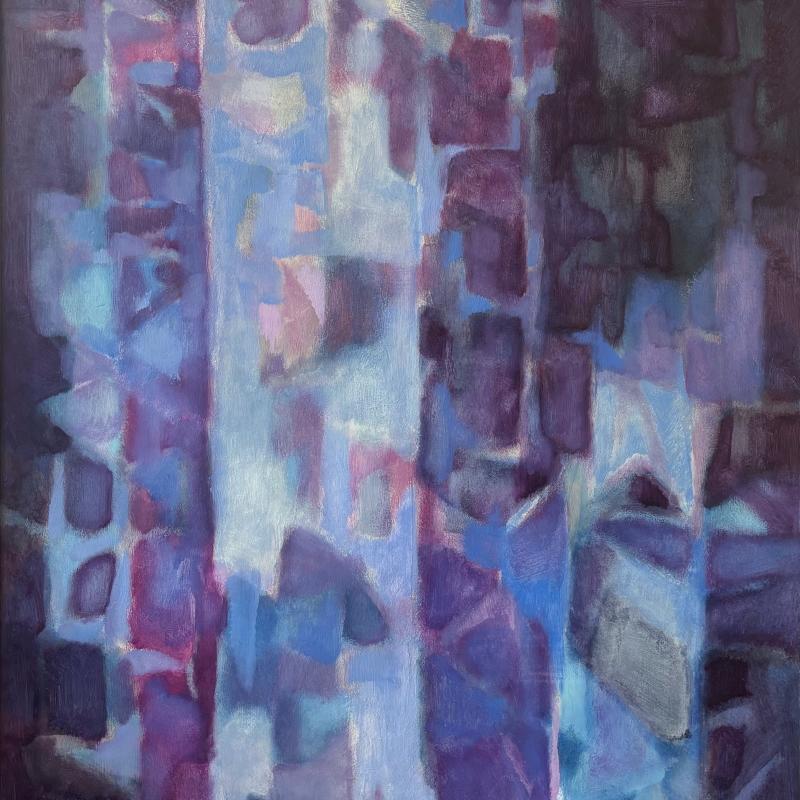 Albert WeinBlue CounterpointOil on paper48 x 36 inches,
Albert WeinBlue CounterpointOil on paper48 x 36 inches,
Framed: 54 1/2 x 43 inchesSigned lower right
-
 Albert WeinCello Player (Tribute to Pablo Casals)Bronze18 3/4 x 8 1/4 x 7 1/2 inches
Albert WeinCello Player (Tribute to Pablo Casals)Bronze18 3/4 x 8 1/4 x 7 1/2 inches
Marble base: 1 5/8 x 7 5/8 x 7 5/8 inchesSigned: Wein 1/9 on base
Marked: Fonderia / Luigi Tommasi / Pietrasanta [foundry]
-
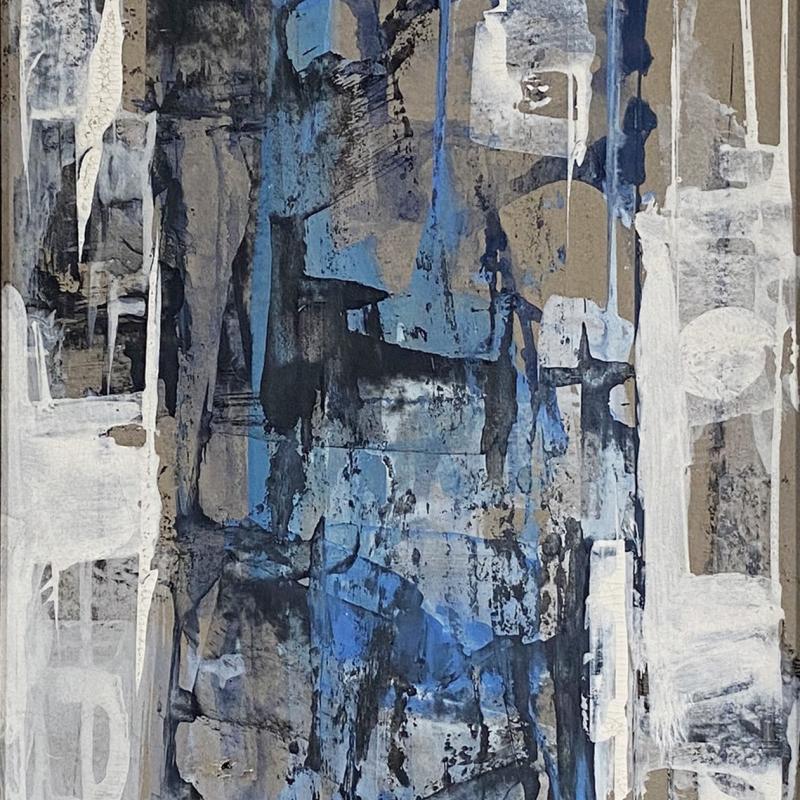 Albert WeinConstruction #1Tempera on board11 3/4 x 5 3/4 inches,
Albert WeinConstruction #1Tempera on board11 3/4 x 5 3/4 inches,
Framed: 18 x 12 inchesSigned: Wein lower right
-
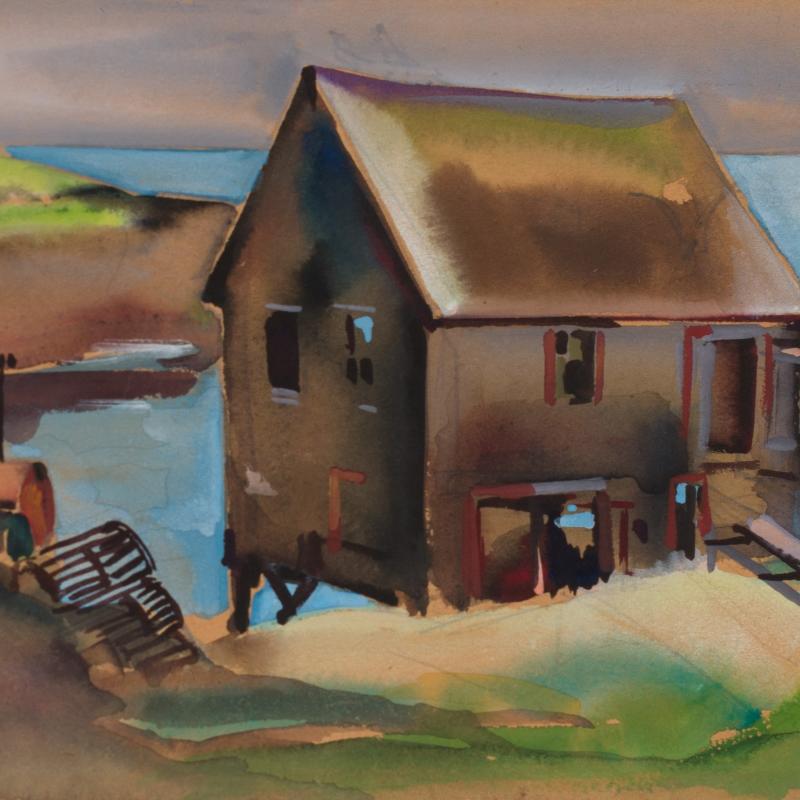 Albert WeinMonhegan House (Fisherman’s Shack)Watercolor9 x 12 inches,
Albert WeinMonhegan House (Fisherman’s Shack)Watercolor9 x 12 inches,
Framed: 19 1/4 x 22 inchesSigned: Wein lower right
-
 Albert WeinMother and ChildSyrian Marble22 1/2 inches high,
Albert WeinMother and ChildSyrian Marble22 1/2 inches high,
28 1/2 inches with base (15 x 11 inches)Signed: Wein (on base)
-
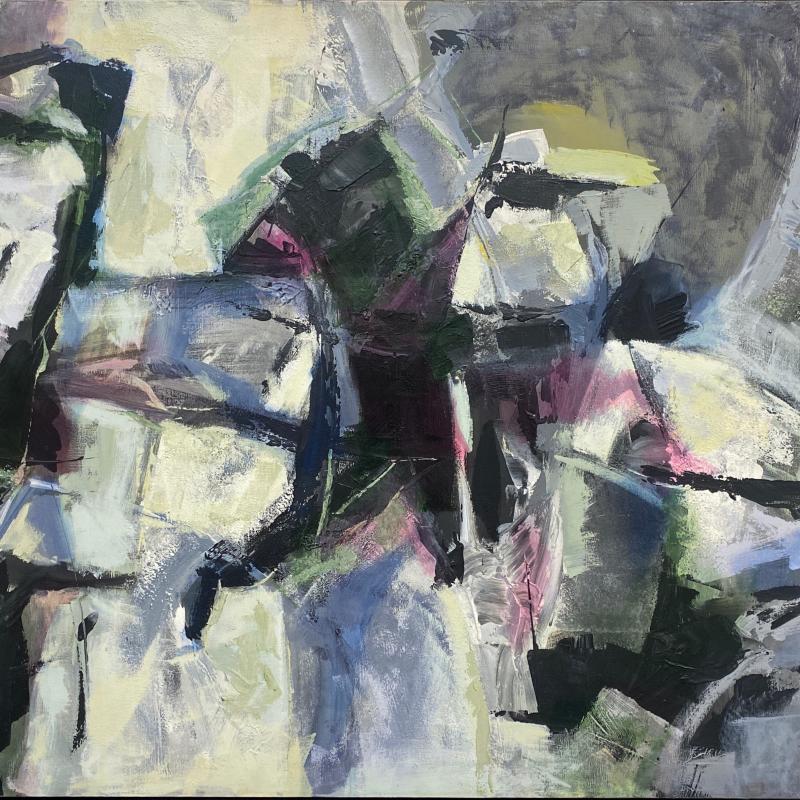 Albert WeinPoncho VillaOil on canvas40 x 60 inches,
Albert WeinPoncho VillaOil on canvas40 x 60 inches,
Framed: 43 1/4 x 63 1/4 inchesSigned: Wein lower right
-
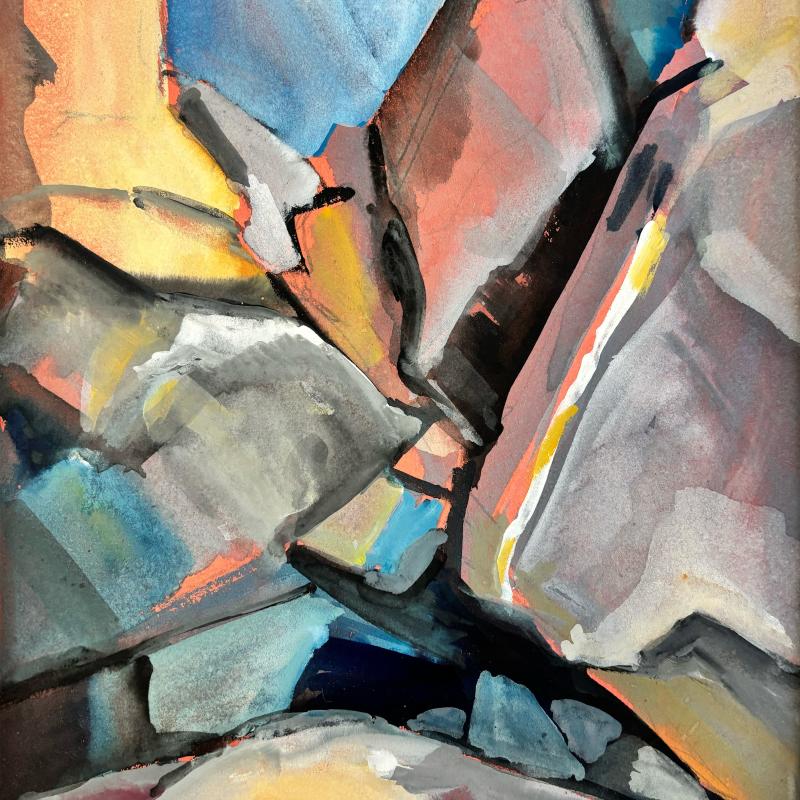 Albert WeinRocky Formation; Monhegan (Red Rocks)Watercolor12 x 9 inchesSigned: Wein lower left
Albert WeinRocky Formation; Monhegan (Red Rocks)Watercolor12 x 9 inchesSigned: Wein lower left
Overview
Albert Wein believed that "every good work of art is a good abstract composition" or could at least be represented by one. That the subject, devoid of details, and pared down to only what is necessary to convey the "essence" of the composition is what really mattered in a truly great work of art according to this recipient of the coveted Prix de Rome and participant in the "watershed" exhibition, American Sculpture in 1951 at the Metropolitan Museum of Art, considered by many to be one of the most important early exhibitions of modernist sculpture in America.
Albert Wein was an artist of innate talent. Sculpture was a great focus in his career but it is evident that he could apply his hand to any art form and exhibit a facile mastery of the medium. He had a wonderful ability with line and was a beautiful draftsman. In the 1950s and 1960s Albert produced quite a body of canvases and works on paper, all in the avant-garde abstract manner that prevailed at that time. Whether it was abstract sculpture or abstract painting, Albert’s subject matter and approach was never on the superficial side.
Albert Wein was born in New York in 1915 and was the only son of an accomplished woman artist, Elsa Wein. Elsa’s influence and intense commitment to nurturing the young Albert’s seemingly insatiable appetite for artistic expression had a profound effect on the developing artist. He built upon this artistic foundation for the rest of his life.
To say that Albert Wein was a child prodigy is no mere boast. In 1927, when Albert was just twelve years old, Elsa Wein, “a true studio mother” moved the family to Maryland so she could enroll the budding young artist, Albert, and herself, into the Maryland Institute College of Art, a school that adhered to a curriculum of “academic based Classicism.” At the time of his enrollment, Albert Wein was the youngest student ever to enroll in the college Art courses at the Maryland Institute.
After more than a year of “rigid” instruction, the 1929 Stock Market crash (and resulting economic impact it had on the Wein family) put an end to his studies at the institute. The family was forced to return to New York City to seek alternative employment.
In 1929 at the age of 14 while attending high school in the Bronx, in New York City, Wein registered for night classes at the National Academy of Design and sought out study in the Life Drawing Class of the well-known American Impressionist painter, Ivan Olinsky. At first, Olinsky’s reaction to the request was not favorable because at the time no 14-year-old student had ever been admitted into a Life Drawing Class at the National Academy. This was due in part to the obvious age requirements in working with live models. Olinsky, after meeting personally with the serious young applicant, reviewed his work and at once recognized Wein’s artistic talent and made an exception for him. Albert Wein once again became the youngest attendee among his peers in an advanced art class.
Early in 1932 Wein enrolled in classes at the Beaux-Arts Institute of Design in New York City where he expanded upon his academic education in sculpture while studying under some of the most prominent practitioners in their field. The Beaux Arts Institute was a school modeled after the Ecole des Beaux-Arts in France and the curriculum (among other things) prepared students for national competitions in the architectural application of their work. This early architectural based training proved to be invaluable throughout Wein’s career as it applied to the large-scale public projects he would later produce.
In 1933, Wein's early inclination towards the modernist art movement that was sweeping America and the rest of the art world led to his decision to enroll in the Hans Hofmann School of Fine Arts at 444 Madison Avenue in New York City. At the time he enrolled, Wein was very aware that Hans Hofmann was regarded as one of the most respected leaders in the forefront of modernism and eagerly anticipated Hofmann’s instruction. It was around this time that Wein, building upon his early unprecedented training in the classical tradition, sculpted "Adam," an early cubist influenced modernist masterwork. This work was a precursor to what would become his signature modernization/stylization of the classical form. In fact, Albert Wein was once quoted as saying that the main thrust of his work was "to modernize and stylize the classical tradition".
In 1934, at the age of 19, Wein took a pay-cut from his secular job as an artist working for an advertising company in New York City to join the WPA. This was an extremely productive period for him and he was able to produce many fine works for both private commissions and award winning national competitions. The works of this period gained him widespread recognition among collectors and fellow artists.
Among the many honors and awards bestowed upon Albert Wein during his illustrious career included those of the coveted Prix de Rome, the highest award in art, “likened to that of the Nobel Prize” the Tiffany Foundation Fellowship, the Rockefeller Foundation grant for study and more. He also participated in the "watershed" exhibition, American Sculpture in 1951 at the Metropolitan Museum of Art. American Sculpture is considered by many to be one of the most important early exhibitions of modernist sculpture in America. In 1979 Wein was elected to full Academician of the National Academy of Design, one of the highest honors an American artist can receive. During his prodigious career he won every major prize available in exhibitions held at the National Sculpture Society and the National Academy of Design, the two leading art institutions of the day.
Some of his important commissions include those for the Brookgreen Gardens, (the world's largest outdoor Sculpture Garden) Steuben Glass Co., The Bronx Zoo, The Franklin Mint and The Libby Dam bas-relief, to name just a few. The latter work, Wein's Libby Dam project was a massive artistic and engineering accomplishment. The three-story sculpture that Wein created is the world’s largest granite bas-relief carving, weighing some 70 tons. It took a team of men working under his direction, three years to complete. The Libby Dam bas-relief "has been likened by critics to other sculptures in the U.S. grand tradition such as Daniel Chester French's seated figure of Abraham Lincoln in Washington, Gutzon Borglum's Mount Rushmore and Paul Manship's gilded bronze statue of Prometheus in Rockefeller Center Plaza."
Wein, in addition to being an excellent sculptor was also a very prolific and talented easel painter who painted in a purely Abstract Expressionist style. He approached painting much the same way he did his sculptural work, from a sound academic based foundation that gave him the legitimacy and freedom to express his modernist views. His paintings have been widely exhibited and have gained him much notoriety.
Very few artists of the twentieth century have so successfully achieved a balance between the extremes of Classicism and Modernism, as did Albert Wein. His sound foundation of academic excellence provided the basis for the stylized, modernistic approach that set him apart from his contemporaries.
Wein Felt that "every good work of art is a good abstract composition" or could at least be represented by one. That the subject, devoid of details, and pared down to only what is necessary to convey the "essence" of the composition is what really mattered in a truly great work of art.
Albert Wein unexpectedly passed away in March of 1991, leaving behind a legacy of spectacular works that have universal appeal in part because of his unique ability to forge a union between centuries of artistic style.
Gordon Friedlander – close friend and son of Albert’s artistic mentor, Leo Friedlander, the 21st president of the National sculpture society stated eloquently: "Albert's work will live on and will endure." These sculptures have already passed the test of time - the true measure of the worth of all creative people."
Memberships
Allied Artists of America
Fellow National Sculpture Society
Fellow American Academy in Rome
Fellow Huntington Hartford Foundation
Fellow Rockefeller Foundation
Fellow International Institute of Arts and Letters
National Academy of Design, Associate Member
National Academy of Design, Full Academician (1975)
National Arts Club
National Sculpture Society
Society of Motion Picture Art Director
Tiffany Foundations Fellowship
Works Project Administrations, (WPA)
Exhibitions
Albert Wein: An American Modernist, September 17 â November 29, 2008, Boston Atheneaum
Architectural League, New York, 1942-6, 1944 (Henry O. Avery Prize)
Arts in Architecture, Los Angeles
Atlanta Terracotta Company, 1934 (prize)
Audubon Artists
Boston Athenaeum, 2008
Briarcliff College Art Gallery, 1976 (Artists Fund Prize)
Canton Museum of Art, 1961
Cowie Gallery, Los Angeles, retrospective 1957-8
David Hatfield Galleries, Palm Springs, California, 1972 (solo)
Grand Central Art Galleries
Heritage Gallery, Los Angeles, 1965, 1967, 1969
Hudson River Art Gallery, 1987 (retrospective)
International Tennis Hall of Fame, Westport, Connecticut, 1977 (Certificate of Merit Prize)
Jewish Museum, New York, 1957-8
Manhattan Galleries, 1959 (solo)
Metropolitan Life Insurance Company, 1938 (prize)
Metropolitan Museum of Art, 1944, 1951
Michel Thomas Galleries, Beverly Hills, California, 1962 (solo)
Municipal Art Gallery, 1938
Museum of Modern Art
National Academy of Design, 1940-2, 1973
National Arts Club
National Sculpture Society, 1942 (prize), 1946 (Lindsey Morris Memorial Prize)
Palace of Legion of Honor, San Francisco, California
Palm Springs Desert Museum, California â Retrospective, 1970
Pennsylvania Academy of the Fine Arts, 1950
Philadelphia Museum of Art, 1949
Salmagundi Club, 1990
Salon dâAutomne, Paris
San Francisco Museum of Art
Sculptorâs Guild, New York
Syracuse University
University of Judaism, Los Angeles, 1958
University of Wyoming
Upstairs Gallery, California â Retrospective, 1971
Whitney Museum of American Art, 1945, 1950
Zautman Gallery, Carmel, California, 1970
Museums and Public Collections
American Academy of Rome, Italy
Boston Museum of Fine Art, MA
Brandeis Institute, CA
Brookgreen Gardens
Bronx Zoo, New York
Cummer Museum of Art, Jacksonville, Florida
Franklin Mint
Gramercy Park Memorial Chapel, NY
Hillside Memorial Park, Culver City, California
Libby Dam, Montana, commissioned by the Army Corps of Engineers, 1973-5
Jewish Museum, NY
National Academy of Design, NY
New York Athletic Club
Palm Springs Desert Museum, California
Steuben Glass
Temple Akiba, Culver City, CA
U.S. Government Libby Dam, WY â largest granite bas-relief
U.S. Post Office, Frankfort, NY
United Nations Medals
University of Wyoming, WY
Vatican Numismatic Museum, Vatican City, NY
West Palm Beach Mall, Florida
West Point Museum, NY
